When building ecommerce sites for clients, you already know that it’s important to consider SEO. But it’s also important to consider that SEO for ecommerce websites is slightly different from SEO for non-retail sites , and keeping those differences in mind is critical when optimizing your clients’ stores.
, and keeping those differences in mind is critical when optimizing your clients’ stores.
In this article, we will investigate these in more detail. Primarily, we will be looking at the below 10 items in our SEO website audit:
- Pagination and the display of longer category listing pages to ensure usability and SEO friendliness
- Faceted navigation, allowing visitors to sub-categorize based on their requirements, without creating duplicate content for search engines
- Product options and how to decide how many product pages to display
- Handling out of stock products, particularly when product pages rank well in the SERPs
- Seasonal product refreshes, ensuring you don’t lose all rankings when a product line refreshes from Spring/Summer to Fall/Winter (and vice versa)
- Optimization, specifically around how to optimize large websites without having to manually create every title tag, while avoiding cannibalization and duplicate title tags
- Orphaned pages, handling your internal navigation, and ensuring rankings aren’t lost due to pages becoming inaccessible
- International targeting, ensuring your site is visible across all countries and that you aren’t creating competition for the client in different countries by using
hreflangtags - Social media and payment options for international websites, making sure you don’t lose customers at the final hurdle
- Making sure you’re thinking ahead to the future of search including mobile, site speed, video, and voice
Let’s go through them one by one.
You might also like: 4 Common SEO Myths and Tips to Avoid Them.
1. Pagination
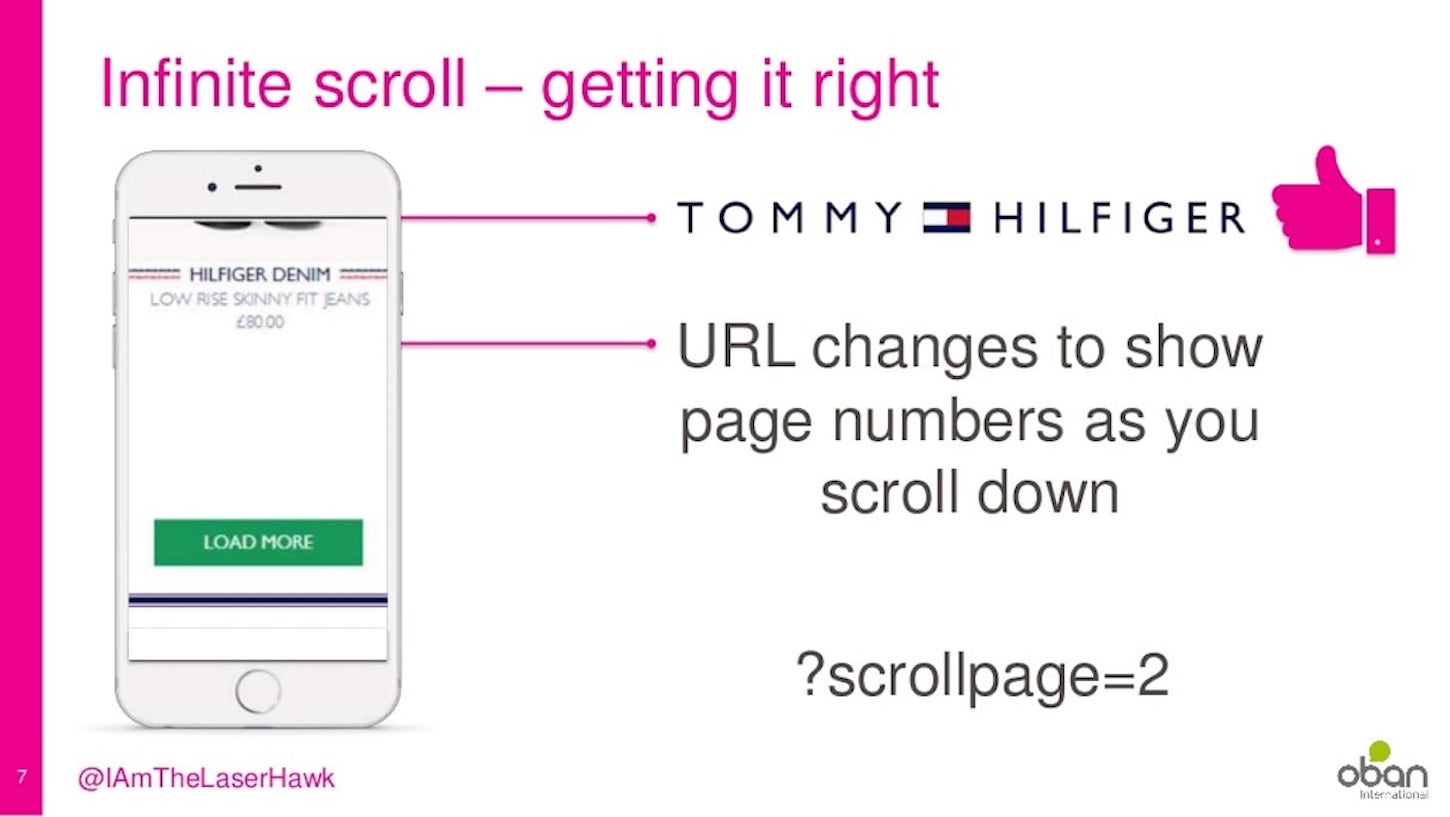
Pagination is often needed on ecommerce websites to split the content of category landing pages into more digestible segments. However, the method of pagination used can have an impact on the SEO performance.
One of the most common methods of implementing pagination is an infinite scroll, which automatically loads more products when a user gets to the bottom of the page, in much the same way to how social networks load more posts. This has some great benefits for users and is also particularly effective in Asia, where website visitors will be used to longer pages with more content.
However, if done incorrectly, infinite scroll can lead to the additional products not being indexed in search engines, as they will be unable to see any products except those in the first load. There are ways to get around this, which will ensure that all of the products on your category page are crawlable.
In order for the search engines to have access to the products, you need some form of static page. There are two ways you can do this:
- Automatically add a pagination element to the URL when a visitor to the page scrolls down—for example,
www.yoursite.com/category/?page=2 - Use pagination tags in the
<head>section of the page to allow search engines access to these pages without showing them in the URL
Both of these methods enable the search engines to place an anchor on the products which are lower down the scroll, so all of the products can be indexed.
2. Faceted navigation
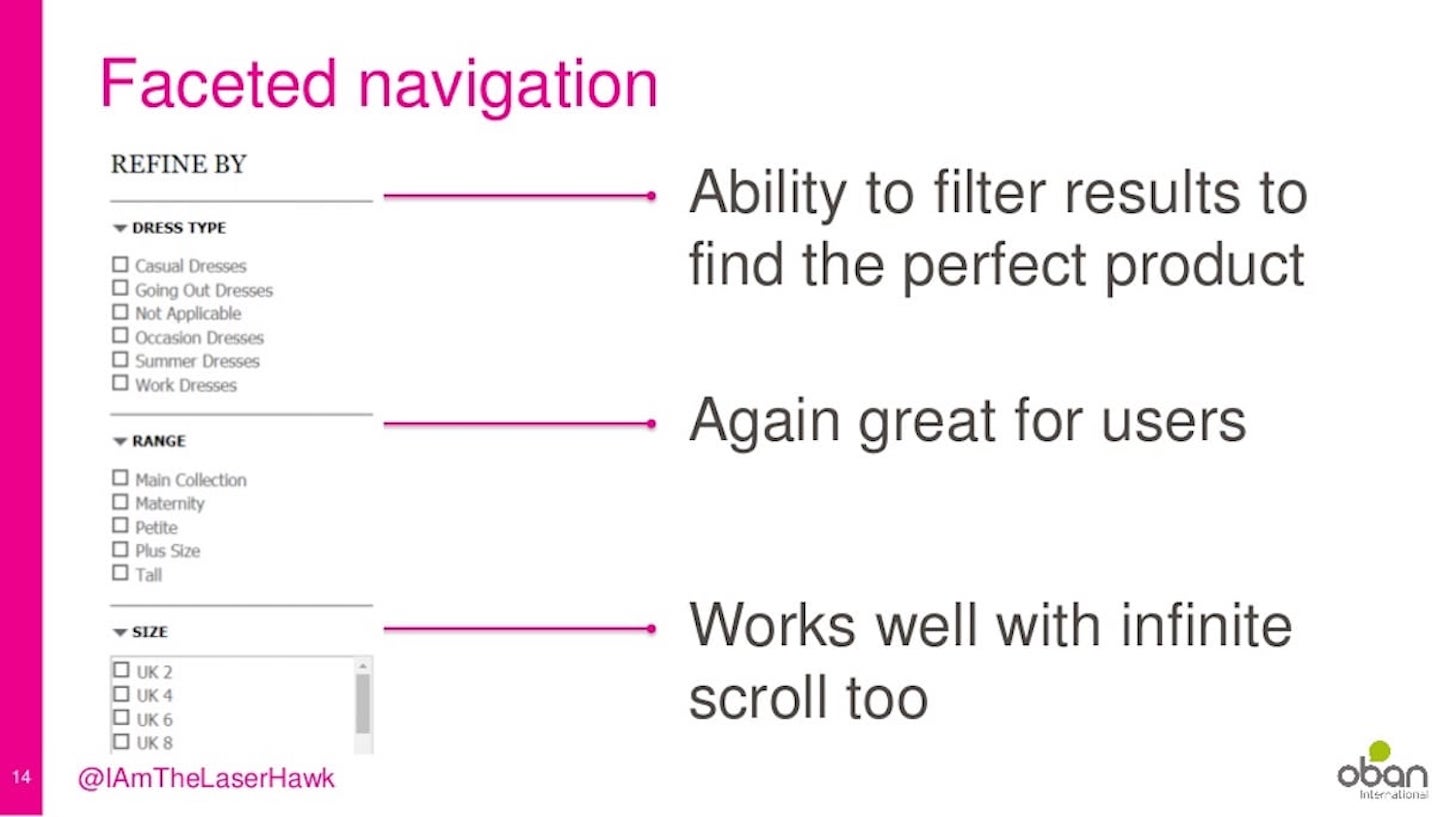
Faceted navigation allows potential customers to filter their way through the range of products your client has on offer. This can be done by size, color, or even style. However, you can end up with lots of very long URLs which contain duplicates of other pages on the site—none of which will help SEO.
You’ll want to ensure that only the master version of the page, unfiltered by any facets, is indexable. Use a combination of canonical tags, robots.txt rules, and noindex tags on filtered pages to make sure you remove any duplicate content issues.
3. Product options
One thing to be cautious of is creating different pages for each option available for a product. For example, if your client sells a pair of shoes available in five colors, some designers like to set up five different product pages—one for each product color. This can result in cannibalization, which means search engines won’t know which page to rank for a keyword. This means that the pages end up competing against each other in the search results.
These types of product options should be presented on one page to avoid duplication and to focus product rankings.
4. Out-of-stock products
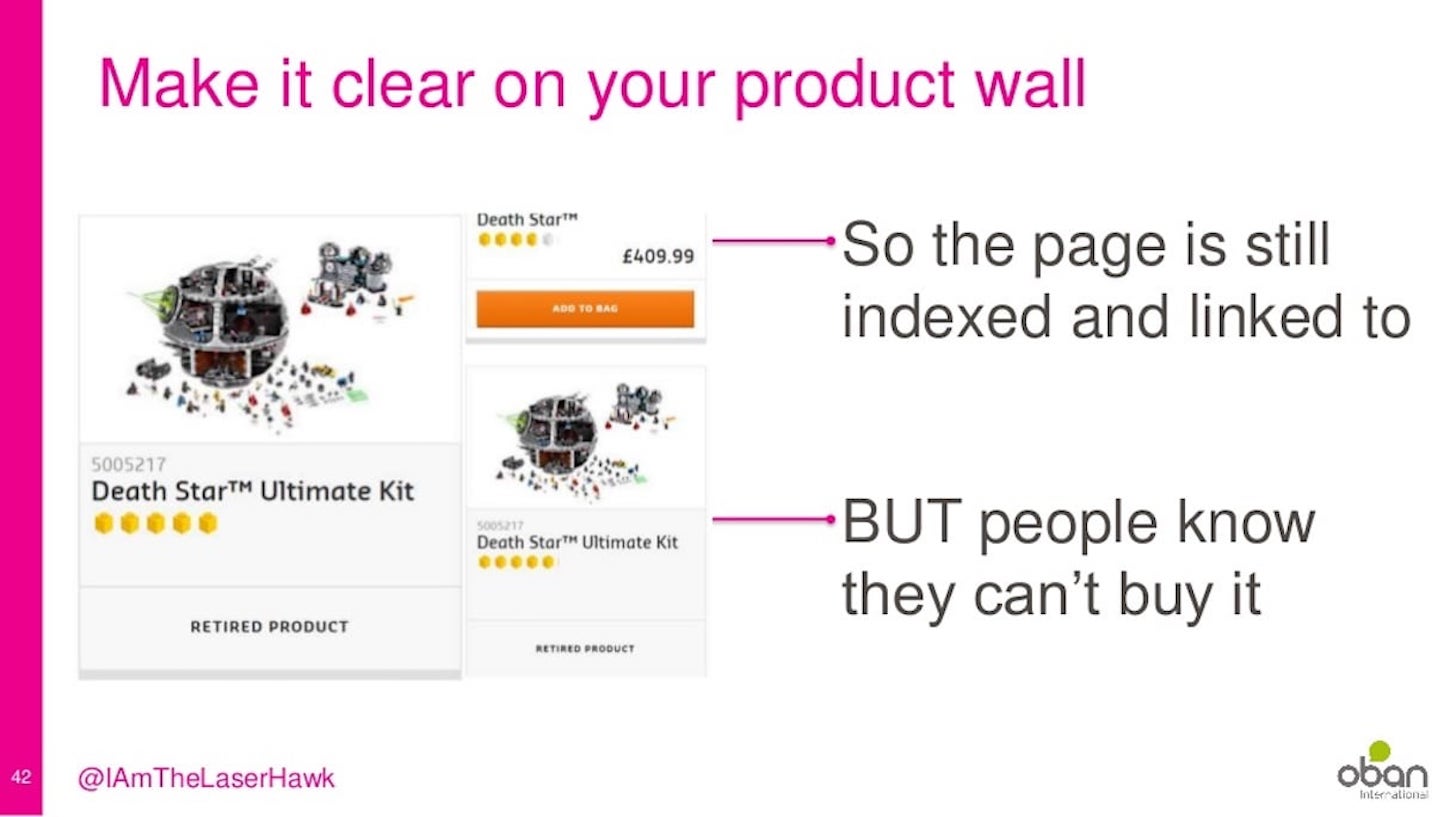
The handling of out-of-stock products can have a negative effect on your client’s website performance.
The best option for SEO is to keep products live but marked as out of stock, so users know they can’t buy them. However, if your client is unable to keep out of stock products live, redirect users to the category landing page. If the product will never come back into stock, use a 301 redirect. If the product will possibly come back into stock, use a 302, which is removed when the stock is available again.
If a product category has no products in stock, it’s more important to keep it live and linked, so you don’t end up with orphaned pages on the site. These pages could be removed from the main menu and added to the HTML sitemap files linked to from your footer.
5. Seasonal product refreshes
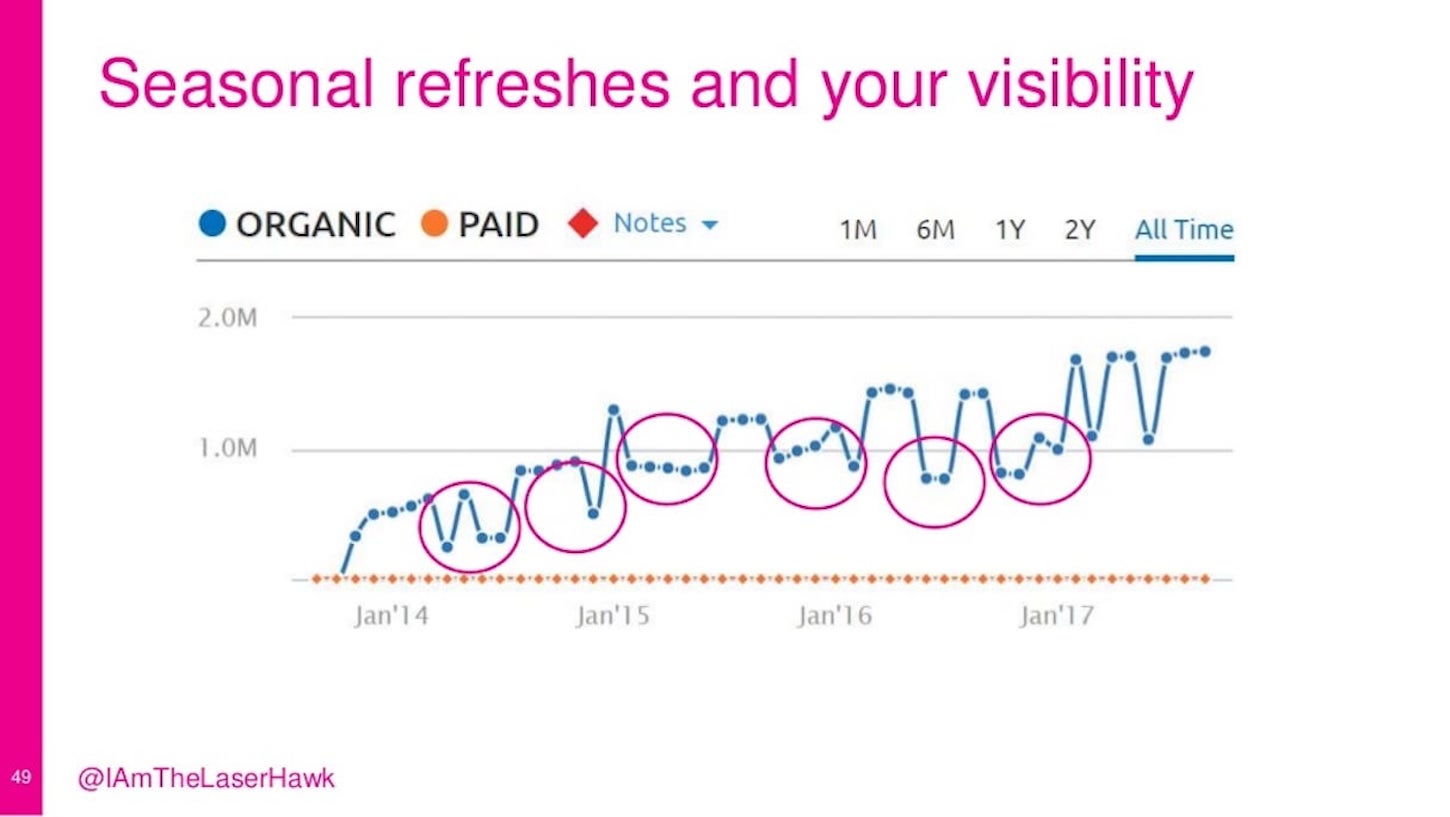
If your client’s retail site is a seasonal business that changes products for Spring/Summer and Fall/Winter, then you may have already experienced fluctuations in visibility.
From the search engines’ perspective, if you remove all of one season’s products and replace them with completely new products, you’re effectively migrating the website once every six months—as the pages that search engines have ranked it for have disappeared.
When seasonally refreshing products, consider keeping category landing pages live, so visitors can still find the site based on core keywords. This also allows you to have a page to keep rankings for out-of-season keywords. That way, you won’t see a massive drop in visibility, or have to start your visibility work from scratch next season, because your ‘jumpers' page lost all of its rankings when it wasn’t live.
The naming convention for your category and product pages should also be keyword focused, and not contain year delimiters, as these would have to be updated every year. So /Cashmere-Jumpers/ is better than /Cashmere-Jumpers-Fall-Winter-2018/ or /Fall-Winter-2018-Cashmere-Jumpers/. Having delimiters in place means that you have to create a new page each season, which would impact visibility and traffic.
6. Optimization recommendations and options
Optimization can take some time when your client has thousands of products on their site. However, there are several ways you can quickly ensure that their pages are all optimized and have unique title tags and meta descriptions.
Let’s start with keyword research. To make sure that you have a strong enough base to optimize from, you need both long- and short-tail keywords to work with. Don’t just focus on the short-tail terms, as you want to make sure you have unique keywords across as many of the pages you are optimizing as possible. When optimizing ecommerce stores, I often end up with a bank of hundreds of keywords, which are split into categories based on the product groups sold on the site I’m working on.
For any paginated category pages, you can easily optimize them by adding in a pagination element to the end of the title tag and meta description. For example, page one would read 'Short-Sleeved Linen Shirts from My Shop', and page two would be 'Short-Sleeved Linen Shirts from My Shop - Page 2'. This adds some unique elements to each page.
For product pages, the sheer number of these can be easily addressed by using a boilerplate, or taxonomy-based optimization rules that can be uploaded to the site. These rules can be determined based on user interest from your in-depth keyword research, and can have the specific product name and stock keeping unit added to them to ensure they are all unique. Doing this will save you writing thousands of unique title tags and meta descriptions by hand.
You might also like: Canonical URLs: What Are They and Why Are They Important?
7. Orphaned pages and internal navigation
Many retail sites have large menus with an array of the product categories listed on them. This approach is key for the indexation of products.
It’s particularly important if your client is a seasonal business and sell products, such as coats or flip-flops, which go in an out of season. Traditionally, we would have removed them from the site during the offseason, but, as mentioned earlier, this can result in pages becoming orphaned on the site, which will have an impact on your visibility. Instead, use a combination of HTML sitemaps and footer links, and consider keeping some offseason pages linked from the main menu, as some customers may still want to buy them.
8. International targeting and opportunities
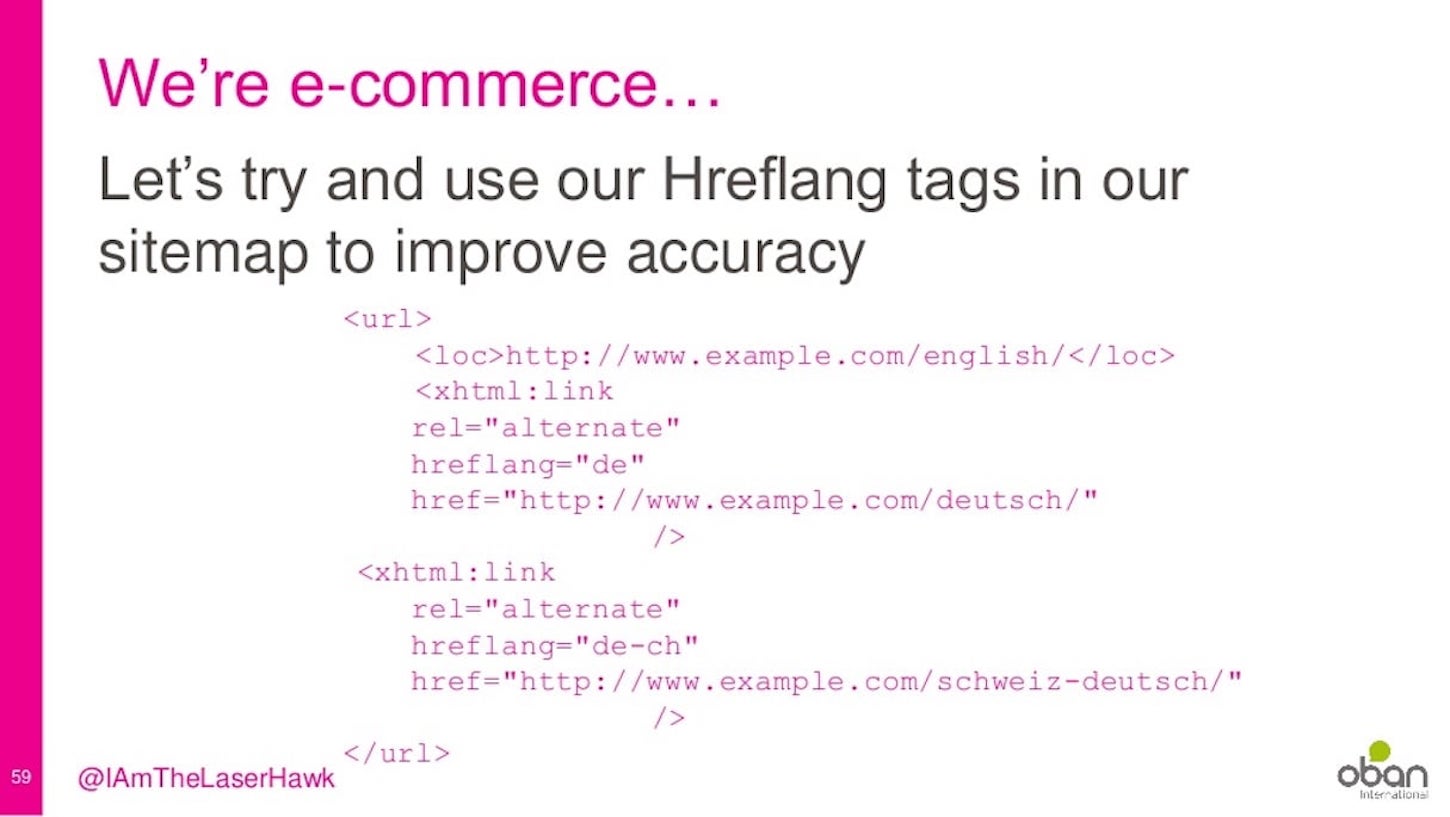
For international targeting, it’s important to have a unique website for each location, which will allow for localized content, product pricing, and delivery information.
Localized content is important for international ecommerce websites, particularly when considering how to handle delivery, privacy, and check-out processes. It’s important to present steps in the purchase process in the native language of your client’s customers, to help them feel more comfortable giving your client their personal information and payment details.
Having localized content will also help you attract new visitors. Search volumes show that people are more likely to search for your products in their local language rather than in English. Remember, your optimization needs to be localized and focused on keywords specific to each language and country, not just translations of your English keywords.
hreflang tags are extremely important to make sure that the right content appears in the right country. These tags are easy to use but also easy to get wrong. For ecommerce websites, place the hreflang tag in the sitemap.xml file rather than on the page. This will help you to ensure that, as the sitemap is automatically generated, out-of-stock products will be taken into account. It also means you don’t have to manually change these, if product stock levels change.
Also remember that you can’t target just a country—you also need to target the language, and make sure that you include all the combinations of languages used in that country. An example of this is Canada, with ca-fr and ca-en.
And don’t forget that these tags can take some time to get working, so don’t expect them to kick in a week after you’ve put them live. As with any SEO, they will take time to be crawled.
You might also like: The Key Aspects to Consider When Building Multilingual Websites.
9. Social media and payment options
When internationalizing a website, make sure you consider how your client’s potential customers want to interact with you. Just like you localized the content, you need to include elements of both social media preferences and payment options for each country your client is serving.
Social media platforms change from country to country. In China, for example, most of the western platforms like Facebook and Twitter are banned. Make sure the sitewide template can be changed, and you aren’t linking to sites people don’t want to use or can’t access.
For payment options, consider the preferred options for each country. Germans like bank transfers as an option, and in India, cash on delivery is popular. In China, payments are made via other platforms such as AliPay and WeChat, whereas Western options like PayPal aren’t used as often.
When adding these payment options to the checkout page, don’t hide them at the bottom. Lead with the main preference for that country to encourage conversion.
10. Mobile, site speed, and future proofing
Future proofing is an important element for any ecommerce strategy. Mobile and site speed are vital as mobile usage increase, so making sure the site is fast and mobile-friendly should be a core focus of the SEO.
Also, take into account other future developments in search such as video, image, and voice search. Be sure to include the following in your strategy:
- Image optimization, alt tags, and sitemaps
- Video optimization, including structured data and not using iFrames
- Structured data around products, articles, and prices for voice search
Invest in the setup and SEO of your online store now
This may sound like quite a bit of work, but getting these steps right will help your client’s store perform better online, both at home and abroad . Taking the time now to invest in the setup and SEO of your client’s online store will help them gain more visibility, and importantly, gain visibility for non-brand keywords, which can be the biggest hurdle for ecommerce sites.
. Taking the time now to invest in the setup and SEO of your client’s online store will help them gain more visibility, and importantly, gain visibility for non-brand keywords, which can be the biggest hurdle for ecommerce sites.
Implementing these changes will help open up the store to new customers and new audiences.
Read more
- SEO and Web Design: How to Build a Website That Ranks (2022)
- What Are the Most Important Website Metrics You Should Track?
- 5 Ways to Overcome Choice Paralysis and Improve Conversion
- Off Page SEO: 3 Quick Fixes and 3 Long Term Strategies
- Why Every Shopify Store Needs a Marketing & Sales Funnel
- Gamification in Business: How to Apply Gaming Principles to Digital Product Design
What SEO tips do you follow? Let us know in the comments below!

